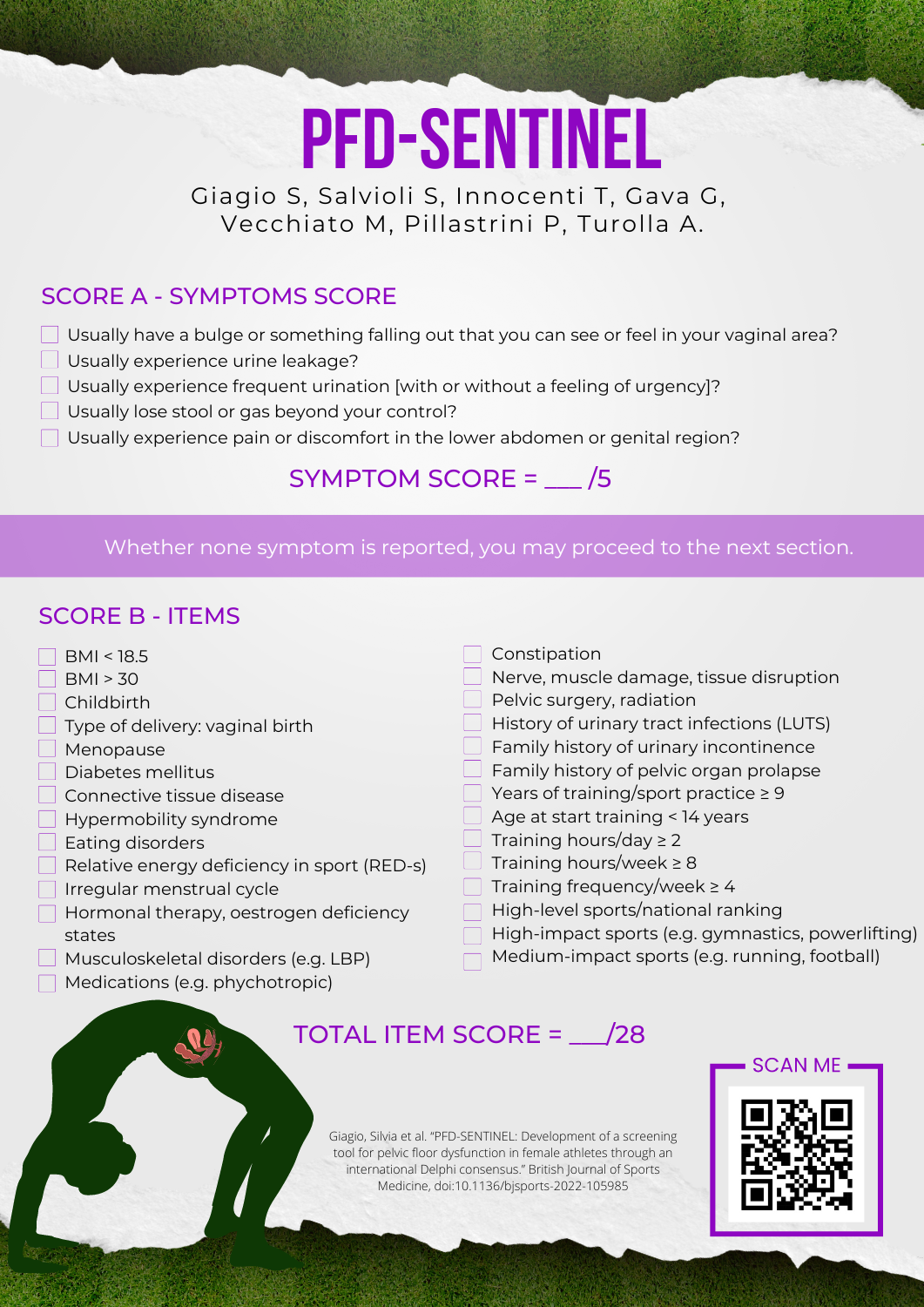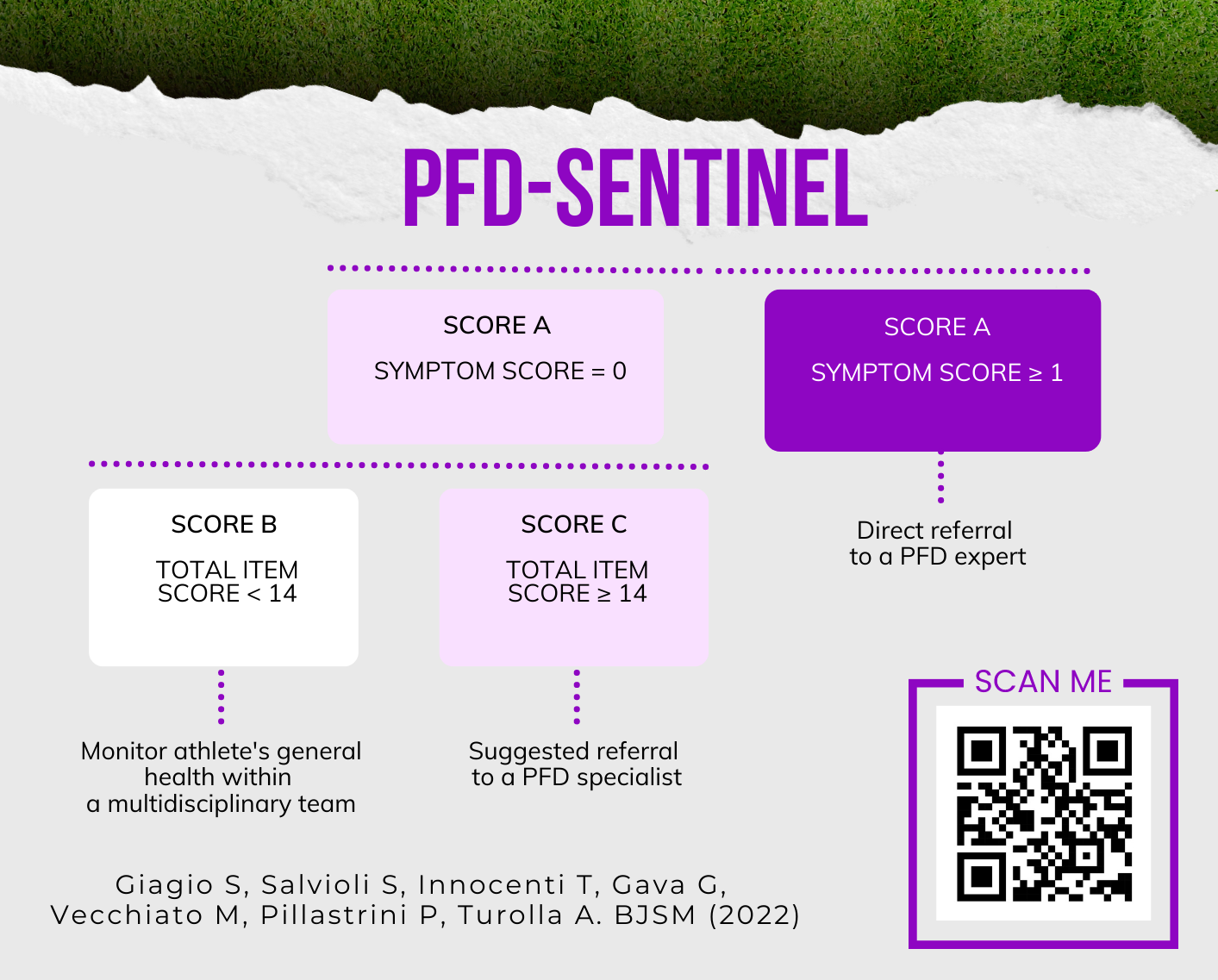PFD-SENTINEL: il primo strumento di screening per le disfunzioni del pavimento pelvico tra le atlete donne
PFD-SENTINEL: the first screening tool for pelvic floor dysfunction in female athletes
Introduction
Evidence suggests the prevalence of Pelvic Floor Dysfunction (PFD) among female athletes is high, with urinary incontinence being particularly common.
Female athletes’ knowledge of PFD is low, and few discuss their condition with medical professionals. Many healthcare providers are also unaware of the potential dysfunction and do not screen for it. This lack of recognition can lead to worsening symptoms, negative impact on performance, and athletes withdrawing from sports.
Although screening tools exist for other conditions, there is currently no tool available for PFD screening specifically for sports medicine clinicians.
This study aimed to develop a screening tool for PFD in female athletes for use by sports medicine clinicians (e.g musculoskeletal/sports physiotherapists, sports and exercise medicine physicians) which guides referral to a PFD specialist (e.g., pelvic floor/women’s health physiotherapist, gynecologist, uro-gynecologist, urologist) through a Delphi consensus.
Methods
A team of Italian researchers developed a screening tool using a Delphi modified consensus through a web-based survey. All complete information are available along the published article.
The target population for the tool is female athletes of any age, performance level, and participating in any type of sport. The clinical condition being considered is any type of PFD. Risk factors and sports-related characteristics (items) associated with PFD in female athletes were extracted from a preliminary search in MEDLINE. Experts’ recruitment relied on non-random, purposive sampling through a literature scan of MEDLINE. Then, an online two-round modified Delphi technique was used to establish agreement among experts on the identified items using a 5-point Likert scale. A consensus was set at 67% agreement or disagreement with a proposal.
Item scores were summarised as appropriate (e.g, frequency and proportions) accompanied by a narrative summary of findings and suggestions.
Results
Among 77 experts, forty-one respondents took part in Round 1 and 34 in Round 2, representing 53.2% (41/77) and 44.2% (34/77) of participants.
Females, Italians, and physiotherapists were the most prevalent sex, nationality, and educational background, respectively. Most participants were currently working as clinicians and researchers (n=22; 53.6%) and reported considerable experience.
Six statements gained immediate consensus by Round 1 and twenty-eight out thirty-seven items were included in the tool. Participants agreed to identify 50% of items (n=14) as a benchmark of total item score for suggesting referral to a PFD specialist. Five out of six symptoms reached the minimum agreement. The majority of experts chose the Pelvic Floor Dysfunction – ScrEeNing Tool IN fEmale athLetes (PFD-SENTINEL) as the official name for the tool (n=16; 47.1%).
Figure 1 shows all the items and PFD symptoms that are included in the PFD-SENTINEL, as well as the clinical algorithm (Figure 2).
Discussion and Conclusion
This 2-round Delphi study involving experts worldwide reached a multidisciplinary consensus on the proposal of the first screening tool for PFD in female athletes. The tool aims to address the barriers in identifying the prevalence and burden of PFD in this population.
The PFD-SENTINEL is a simple and user-friendly tool consisting of two sections to screen for symptoms and risk factors associated with PFD and provides a scoring algorithm to determine whether referral to a specialist is necessary. The tool should be administered regularly and can be used during the pre-season, after enforced breaks, and among athletes returning to sport after pregnancy.
However, education of clinicians, as well as a confidential setting for using the tool, may be necessary. The study has strengths in its novelty and transparency, but limitations include the representativeness of the expert panel. Further validation studies are necessary to test the screening tool accuracy.
REFERENCES
Giagio S, Salvioli S, Innocenti T, et al. PFD-SENTINEL: Development of a screening tool for pelvic floor dysfunction in female athletes through an international Delphi consensus [published online ahead of print, 2022 Dec 14]. Br J Sports Med. 2022;bjsports-2022-105985. doi:10.1136/bjsports-2022-105985
Abrams P, Cardozo L, Wagg A, et al. Incontinence. 6th Editio. ICI-ICS. International Continence Society, Bristol UK 2017.
Giagio S, Salvioli S, Pillastrini P, et al. Sport and pelvic floor dysfunction in male and female athletes: A scoping review. Neurourol Urodyn 2021;40:55–64. doi:10.1002/nau.24564
McKenna HP. The Delphi technique: a worthwhile research approach for nursing? J Adv Nurs 1994;19:1221–5. doi:https://doi.org/10.1111/j.1365-2648.1994.tb01207.x


